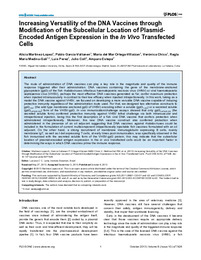Por favor, use este identificador para citar o enlazar este ítem:
https://hdl.handle.net/11000/34450Registro completo de metadatos
| Campo DC | Valor | Lengua/Idioma |
|---|---|---|
| dc.contributor.author | Martinez-Lopez, Alicia | - |
| dc.contributor.author | Garcia Valtanen, Pablo | - |
| dc.contributor.author | Ortega-Villaizan, Maria del Mar | - |
| dc.contributor.author | CHICO GRAS, VERONICA | - |
| dc.contributor.author | Medina Gali, Regla María | - |
| dc.contributor.author | Perez, Luis | - |
| dc.contributor.author | coll, julio | - |
| dc.contributor.author | ESTEPA, AMPARO | - |
| dc.date.accessioned | 2025-01-14T12:58:29Z | - |
| dc.date.available | 2025-01-14T12:58:29Z | - |
| dc.date.created | 2013-10 | - |
| dc.identifier.citation | PLoS ONE, October 2013 | Volume 8 | Issue 10 | es_ES |
| dc.identifier.issn | 1932-6203 | - |
| dc.identifier.uri | https://hdl.handle.net/11000/34450 | - |
| dc.description.abstract | The route of administration of DNA vaccines can play a key role in the magnitude and quality of the immune response triggered after their administration. DNA vaccines containing the gene of the membrane-anchored glycoprotein (gpG) of the fish rhabdoviruses infectious haematopoietic necrosis virus (IHNV) or viral haematopoietic septicaemia virus (VHSV), perhaps the most effective DNA vaccines generated so far, confer maximum protection when injected intramuscularly in contrast to their low efficacy when injected intraperitoneally. In this work, taking as a model the DNA vaccine against VHSV, we focused on developing a more versatile DNA vaccine capable of inducing protective immunity regardless of the administration route used. For that, we designed two alternative constructs to gpG₁₋₅₀₇ (the wild type membrane-anchored gpG of VHSV) encoding either a soluble (gpG₁₋₄₆₂) or a secreted soluble (gpG(LmPle20-462)) form of the VHSV-gpG. In vivo immunisation/challenge assays showed that only gpG(LmPle20-462) (the secreted soluble form) conferred protective immunity against VHSV lethal challenge via both intramuscular and intraperitoneal injection, being this the first description of a fish viral DNA vaccine that confers protection when administered intraperitoneally. Moreover, this new DNA vaccine construct also conferred protection when administered in the presence of an oil adjuvant suggesting that DNA vaccines against rhabdoviruses could be included in the formulation of current multicomponent-intaperitoneally injectable fish vaccines formulated with an oil adjuvant. On the other hand, a strong recruitment of membrane immunoglobulin expressing B cells, mainly membrane IgT, as well as t-bet expressing T cells, at early times post-immunisation, was specifically observed in the fish immunised with the secreted soluble form of the VHSV-gpG protein; this may indicate that the subcellular location of plasmid-encoded antigen expression in the in vivo transfected cells could be an important factor in determining the ways in which DNA vaccines prime the immune response. | es_ES |
| dc.format | application/pdf | es_ES |
| dc.format.extent | 12 | es_ES |
| dc.language.iso | eng | es_ES |
| dc.publisher | Public Library of Science | es_ES |
| dc.rights | info:eu-repo/semantics/openAccess | es_ES |
| dc.rights | Attribution-NonCommercial-NoDerivatives 4.0 Internacional | * |
| dc.rights.uri | http://creativecommons.org/licenses/by-nc-nd/4.0/ | * |
| dc.subject.other | CDU::6 - Ciencias aplicadas::60 - Cuestiones generales de las ciencias aplicadas | es_ES |
| dc.title | Increasing Versatility of the DNA Vaccines through Modification of the Subcellular Location of PlasmidEncoded Antigen Expression in the In Vivo Transfected Cells | es_ES |
| dc.type | info:eu-repo/semantics/article | es_ES |
| dc.contributor.institute | Institutos de la UMH::Instituto de Investigación, Desarrollo e Innovación en Biotecnología Sanitaria de Elche | es_ES |
| dc.relation.publisherversion | https://doi.org/10.1371/journal.pone.0077426 | es_ES |

Ver/Abrir:
file.pdf
741,52 kB
Adobe PDF
Compartir:
 La licencia se describe como: Atribución-NonComercial-NoDerivada 4.0 Internacional.
La licencia se describe como: Atribución-NonComercial-NoDerivada 4.0 Internacional.
.png)